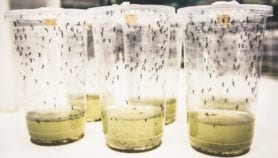By: Christine Ottery
Send to a friend
The details you provide on this page will not be used to send unsolicited email, and will not be sold to a 3rd party. See privacy policy.
The many negative effects of deforestation are well-known, but scientists have shown that farmers may derive one advantage from planting in deforested areas that are sandwiched between patches of forest.
Converting rainforests into cropland increases rainfall in the new cropland by four to six times, but halves the amount of rain over the forest, says a modelling study by scientists from the University of Leeds, United Kingdom.
The effect stems from the heat difference between air over the cropland and nearby rainforest, said Luis Garcia-Carreras, the lead author of the study, which has been accepted for publication in Geophysical Research Letters. "The cropland is hotter … this causes a local wind similar to a sea breeze, bringing rain from over the rainforest to the cropland," he said.
Converting forests to pasture and cropland can create sharp gradients in temperature and changes in local air circulation, but until now the effects on rainfall were unknown. Scientists used modelling to investigate the effect deforestation had on local rainfall.
Their results show that when the deforested patch is around 20-30 km wide it creates a breeze that results in higher rainfall in the deforested area but lower in the remaining forest.
The pattern of deforestation could be important for farmers, said Garcia-Carreras.
"If you want to maximise rain over crops, then creating patterns with forest either side would do that, similar to the fishbone deforestation patterns in the Amazon," he told SciDev.Net. "The flip side is that you’re reducing rainfall over the rainforest, and the impact of that is unknown."
Chris Taylor, from the UK’s Centre for Ecology & Hydrology, told SciDev.Net: "This is the first significant quantitative view of how spatial variability can affect rainfall, over both cropland areas and rainforest areas".
Tim Baker, an expert in rainforest geography — also at the University of Leeds — who was not involved with the study, said the findings have implications for agriculture. "If you get elevated rainfall near to tropical forests, crops might do better, and it might even increase the period in the year when crops can grow," he said.
But he added that this is a modelling study and in reality rainfall is influenced by other factors.
Baker cautioned that the forests hold much more value for people than just rainfall creation and that it is hard to say what, if any, policy recommendations follow from these findings. "There is so much deforestation in West Africa that the forests in many areas, such as Ghana, are already very fragmented," he said.
Garcia-Carreras said that further work would focus on putting together the small- and large-scale processes, and gathering observations of rain over West Africa. Studies that look more closely at the effects rainfall difference would have on land surface are crucial to understanding long-term effects of deforestation, and its impact on farmers and forest livelihoods, he said.
References
Geophysical Research Letters doi:10.1029/2011GL049099 (2011)













